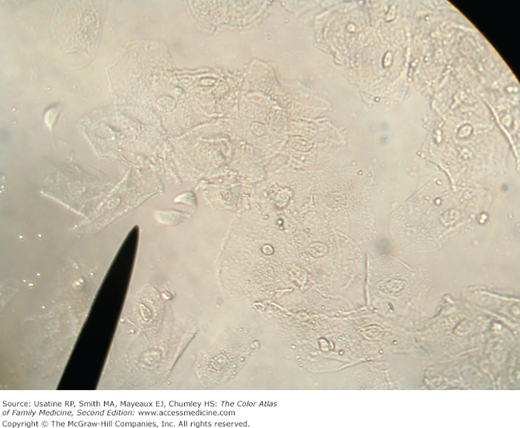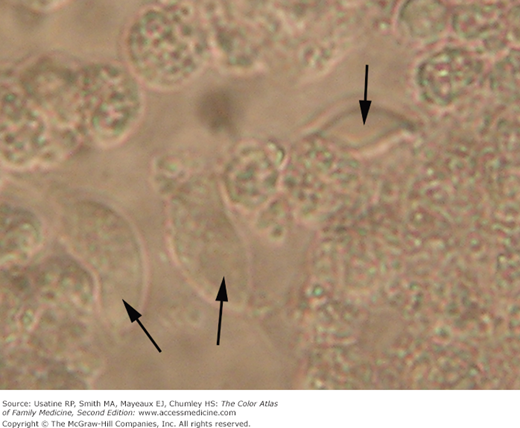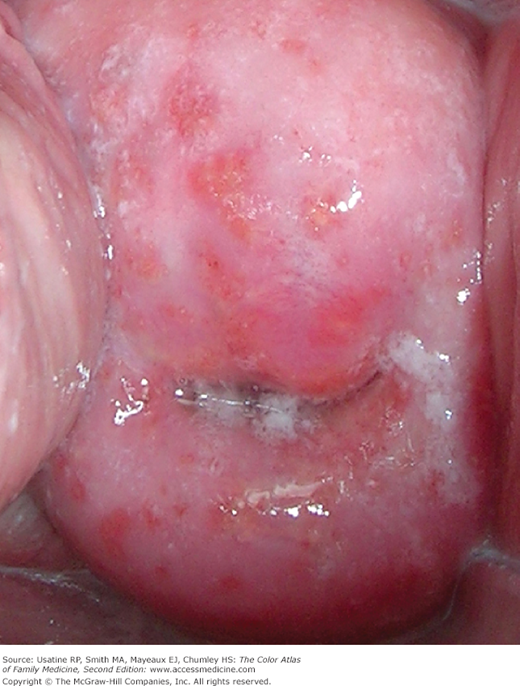Patient Story
A 27-year-old woman presents with a vaginal itching, odor, and discharge for 1 week. She has one partner who is asymptomatic. Speculum examination shows a strawberry cervix seen with Trichomonas infections (Figure 84-1). This strawberry pattern is caused by inflammation and punctate hemorrhages on the cervix. There is a scant white discharge with a fishy odor. Wet mount shows trichomonads swimming in saline (Figures 84-2 and 84-3). The trichomonads are larger than white blood cells (WBCs) and have visible flagella and movement. She is diagnosed with trichomoniasis and treated with 2 g of metronidazole in a single dose. The patient is tested for other sexually transmitted diseases (STDs) and her partner is treated with the same regimen.
Introduction
Epidemiology
Etiology and Pathophysiology
- Trichomonas infection is caused by the unicellular protozoan T. vaginalis.3
- The majority of men (90%) infected with T. vaginalis are asymptomatic, but many women (50%) report symptoms.4
- The infection is predominantly transmitted via sexual contact. The organism can survive up to 48 hours at 10°C (50°F) outside the body, making transmission from shared undergarments or from infected hot spas possible although extremely unlikely.
- Trichomonas infection is associated with low-birth-weight infants, premature rupture of membranes, and preterm delivery in pregnant patients.5
- In a person coinfected with HIV, the pathology induced by T. vaginalis infection can increase HIV shedding. Trichomonas infection may also act to expand the portal of entry for HIV in an HIV-negative person. Studies from Africa have suggested that T. vaginalis infection may increase the rate of HIV transmission by approximately two-fold.6
Risk Factors
- New or multiple partners.3
- A history of STDs.
- Exchanging sex for payment or drugs.
- Injection drug use.
Diagnosis
- The physical examination should include inspection of the external genitalia for irritation or discharge. Speculum examination is done to determine the amount and character of the discharge and to look for the characteristic strawberry cervix (Figures 84-1 and 84-4).
- Typically, women with trichomoniasis have a diffuse, malodorous, yellow-green discharge (Figure 84-5) with vulvar irritation.3 Vaginal and vulvar itching and irritation are common.
- It should be determined whether the patient douched recently, because this can lower the yield of diagnostic tests. Patients who have been told not to douche will sometimes start wiping the vagina with soapy washcloths to “keep clean” as an alternative. This greatly irritates the vagina and cervix, lowers test sensitivity, and may cause a discharge.
Stay updated, free articles. Join our Telegram channel

Full access? Get Clinical Tree






